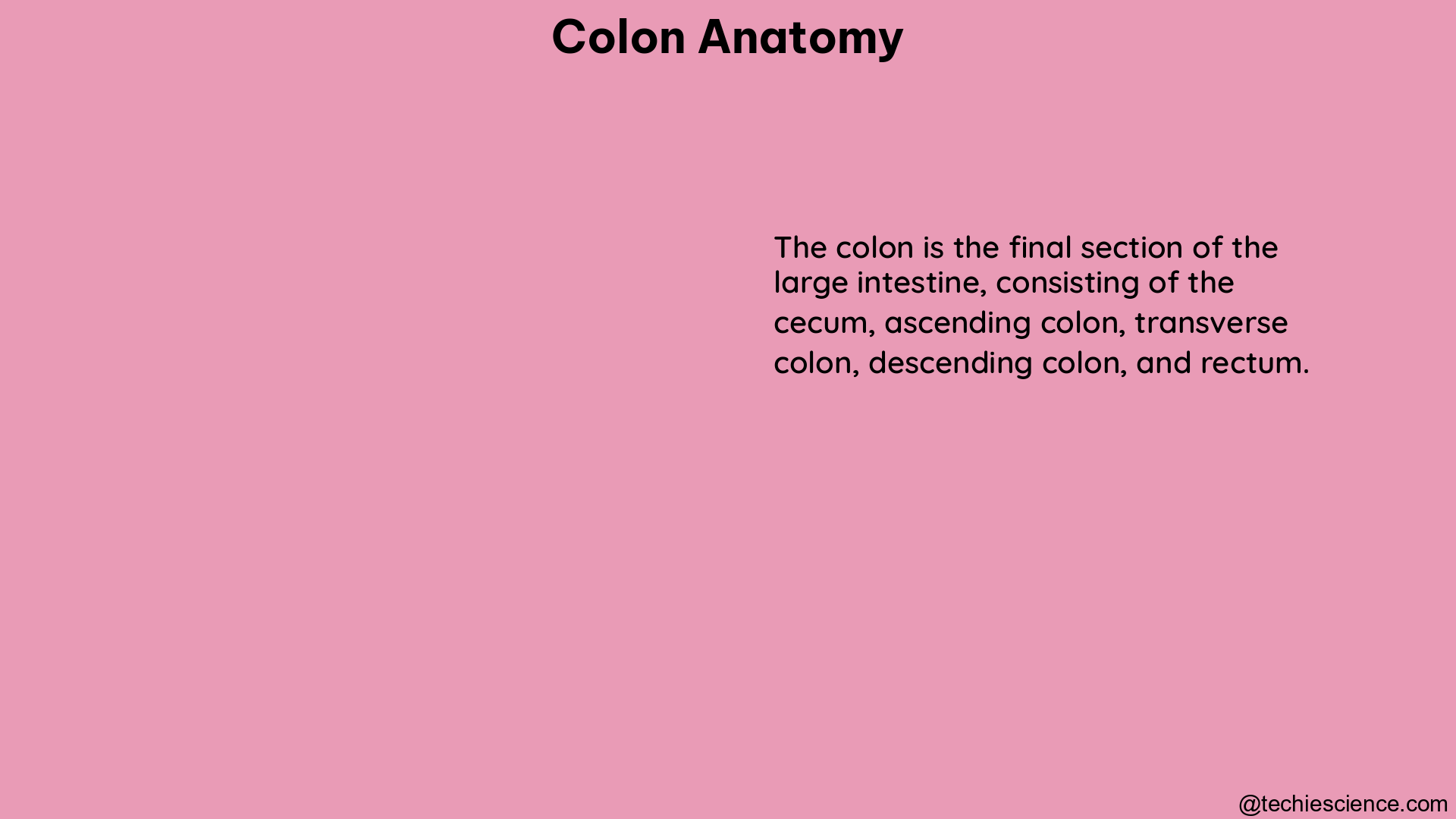The colon, a vital component of the large intestine, plays a crucial role in the human digestive system. This remarkable organ is responsible for absorbing water and electrolytes, as well as storing and eliminating waste matter. To fully understand the colon’s function, it is essential to delve into its intricate anatomy.
The Colon’s Layers: A Structural Masterpiece
The colon’s wall is composed of four distinct layers, each with its own unique characteristics and functions:
- Mucosa: The innermost layer of the colon, the mucosa, is lined with a specialized epithelium that serves as the primary site of absorption and secretion. This layer is home to two key cell types:
- Enterocytes: These absorptive cells are responsible for the uptake of water, electrolytes, and nutrients from the intestinal lumen.
-
Goblet Cells: These specialized cells secrete a protective layer of mucus, which lubricates the colon and shields the underlying tissue from the harsh environment of the digestive tract.
-
Submucosa: Beneath the mucosa lies the submucosa, a layer rich in connective tissue, blood vessels, and a network of nerves known as Meissner’s plexus. This plexus plays a crucial role in regulating the colon’s motility and secretory functions.
-
Muscularis Externa: The muscularis externa, the third layer of the colon’s wall, is composed of two distinct muscle layers: an inner circular layer and an outer longitudinal layer. These smooth muscle fibers work in coordination to propel the contents of the colon through peristaltic movements.
-
Serosa: The outermost layer of the colon’s wall is the serosa, a thin, protective membrane that helps to shield the organ from infection and external damage.
Cellular Composition and Organization: Variations along the Colon

The cellular composition and organization of the colon’s wall vary significantly along the length of the organ. This heterogeneity is not an artifact of sampling, but rather a reflection of the colon’s functional adaptations.
-
Endothelial Cells: The number of endothelial cells, which line the blood vessels, decreases from the small intestine to the colon. This change is thought to be related to the colon’s primary function of water and electrolyte absorption, rather than nutrient absorption.
-
Smooth Muscle Cells: In contrast, the number of smooth muscle cells increases from the small intestine to the colon. This increase in muscle mass is crucial for the colon’s ability to propel its contents through peristaltic movements.
Mechanical Properties: Insights into Inflammatory Bowel Disease
The colon’s mechanical properties, such as stiffness and fibrosis, have been the subject of extensive research, particularly in the context of inflammatory bowel diseases (IBD) like Crohn’s disease and ulcerative colitis.
-
Tissue Stiffness: Studies have shown that the colon’s tissue stiffness is significantly higher in regions affected by inflammation compared to unaffected areas. This increased stiffness is likely a result of the fibrotic changes that occur in response to chronic inflammation.
-
Fibrosis: The colon’s fibrosis, or the excessive deposition of connective tissue, has also been quantified in patients with IBD. Similar to tissue stiffness, the degree of fibrosis is greater in inflamed regions of the colon, which can further impair the organ’s function and contribute to the development of complications.
Functional Implications: The Colon’s Crucial Role
The colon’s intricate anatomy is directly linked to its essential functions within the digestive system:
-
Water and Electrolyte Absorption: The colon’s mucosa, with its specialized enterocytes, is responsible for the absorption of water and electrolytes, helping to maintain fluid balance and prevent dehydration.
-
Fecal Matter Storage and Elimination: The colon’s muscular layers, in coordination with the nervous system, facilitate the storage and eventual elimination of fecal matter, a crucial step in the digestive process.
-
Immune Function: The colon’s mucosal layer, with its goblet cells and associated immune cells, plays a vital role in the body’s defense against pathogens and the maintenance of a healthy gut microbiome.
Conclusion
The colon’s anatomy is a testament to the human body’s remarkable complexity and adaptability. By understanding the intricate details of the colon’s structure, cellular composition, and mechanical properties, researchers and clinicians can gain valuable insights into the organ’s function and its role in various digestive disorders. This knowledge can pave the way for the development of more effective diagnostic and therapeutic strategies, ultimately improving the quality of life for individuals with colon-related health conditions.
References:
– Sigmoid Colon Anatomy
– Colon Histology
– Cellular Composition of the Colon
– Colon Mechanical Properties in IBD
– Colon, Cecum, and Appendix

The lambdageeks.com Core SME Team is a group of experienced subject matter experts from diverse scientific and technical fields including Physics, Chemistry, Technology,Electronics & Electrical Engineering, Automotive, Mechanical Engineering. Our team collaborates to create high-quality, well-researched articles on a wide range of science and technology topics for the lambdageeks.com website.
All Our Senior SME are having more than 7 Years of experience in the respective fields . They are either Working Industry Professionals or assocaited With different Universities. Refer Our Authors Page to get to know About our Core SMEs.